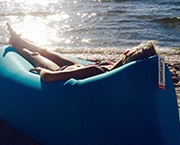 The way you protect Intellectual Property depends on whether the invention is of a technical or esthetic nature. It goes without saying that there is also a grey area in between.
The way you protect Intellectual Property depends on whether the invention is of a technical or esthetic nature. It goes without saying that there is also a grey area in between.
At first glance, the distinction between a patent and design right appears to be fairly clear cut. If your invention is of a technical nature, you will need to protect it with a patent. If your product is based on a unique, beautiful design, a design right will provide the most adequate form of protection. Having said that, in everyday practice I still come across situations in which the type of protection is debatable, even in court.
Sausage-shaped lounge bag
I can demonstrate this using a recent infringement case. Dutch designer Marijn Oomen developed a special lounger or lounge bag by trial and error and launched it onto the market. His operations were taken over by a Dutch company by the name of Fatboy. All the user needs to do to fill the plastic sausage-shaped bean bag with air is to swing it around a couple of times. This makes the Lamzac an 'inflatable' lounger which you can easily take with you to the beach, the park or to parties or festivals.
Similar product
I immediately advised Fatboy to take legal action when a similar product was offered online under the name of Kaisr. One important argument used by Kaisr was that the design right with which Fatboy had protected its Lamzac was not applicable because Fatboy's design is technically determined. Ergo, the Lamzac should have been protected with a patent, not with a design right, in this competitor's opinion.
Funny and striking
The court and the court of appeal agreed with us that the Kaisr was indeed infringing and that the Lamzac's design was not technically determined. After all, the success of a bean bag or couch depends on its special design, which is often funny and striking. The technology used is therefore subordinate to that and follows the design, despite the fact that various features of the Lamzac are, in fact, technically determined. Both the swinging movement and the overall dimensions are driven by technical considerations. However, that still leaves so much freedom in terms of formability that there are sufficient 'realistic alternatives'.
Socket
In everyday practice I occasionally notice that technically determined products are protected with a design right and that the court then has to decide whether the person who came up with the idea for the product should have protected it with a patent. This is exactly what happened in recent proceedings involving a socket, which indeed did not offer a great deal of freedom in terms of formability. The person who came up with the idea for the socket ended up losing the case due to a lack of 'realistic alternatives'.
Solution
I have an adequate solution for situations like this, which involves protecting the product with a patent as well as a design right. However, it is important in such cases to ensure that the drawings used for the patent are of a 'more technical nature' than the ones used for the design right. The latter ones need to emphasize the beautiful design and ignore the technology involved. This ensures that the patent and the design right are not at odds with each other.









